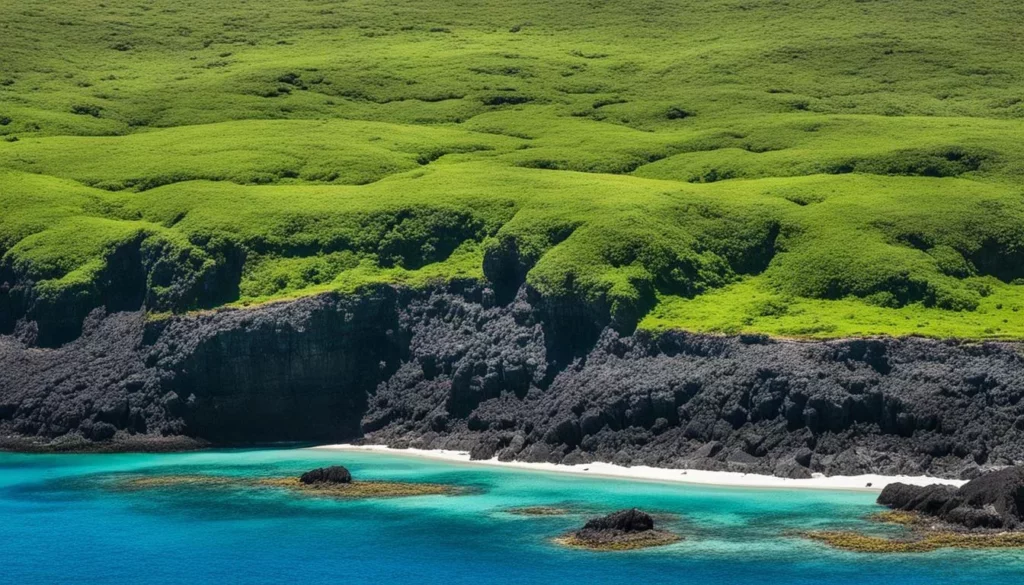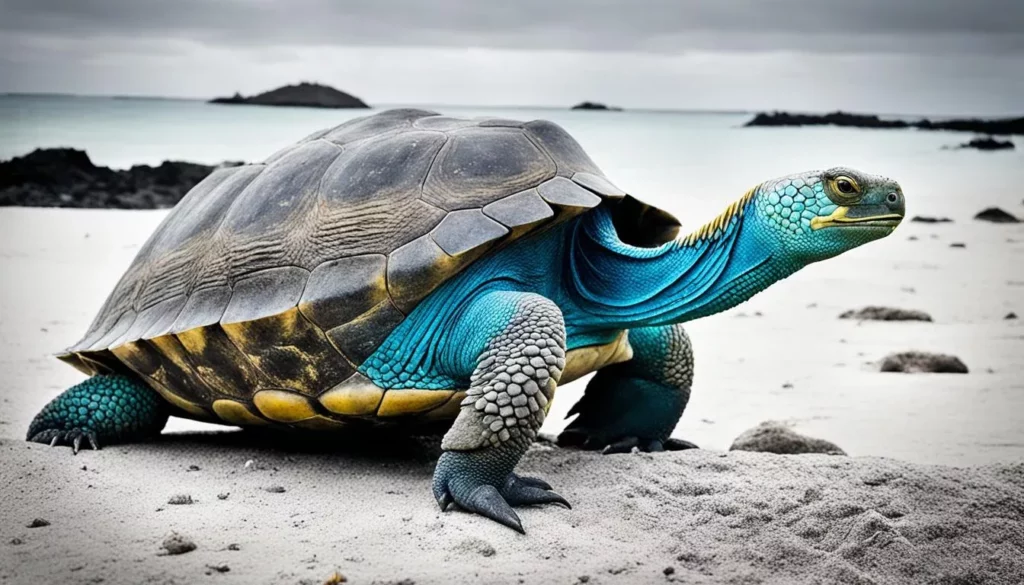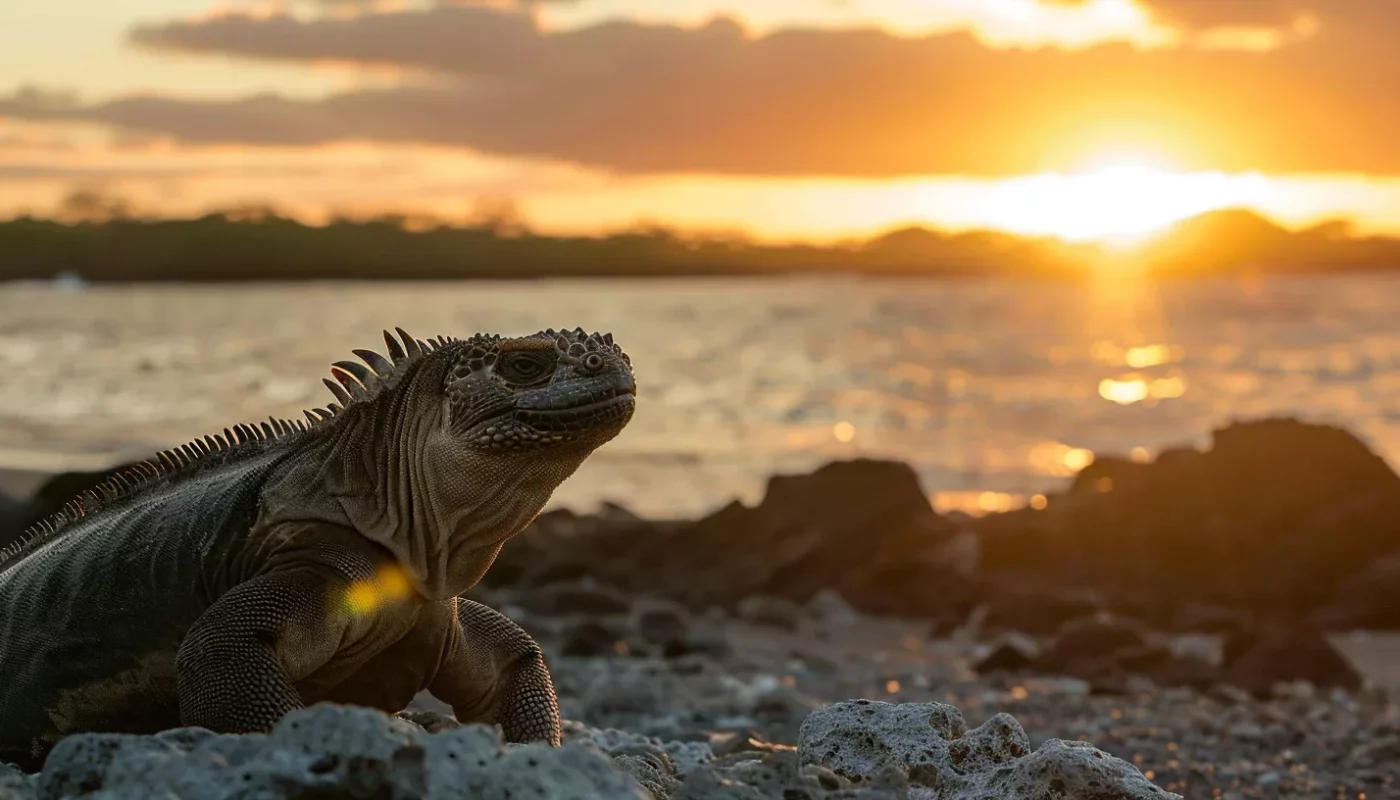Did you know the Galápagos Islands have lots of unique species? These islands are known as Darwin’s natural lab. This is because Charles Darwin made big discoveries here for his work “On the Origin of Species.”
Today, the Galápagos are still important for scientists and those curious about nature. They show evolution happening before our eyes. With its unique animals, like finches with special beaks and swimming iguanas, the Galápagos show how life changes and adapts.
Introduction to the Galápagos Islands
The Galápagos Islands lie about 600 miles from Ecuador’s coast. They form a fascinating volcanic group in the Pacific Ocean. Known for their unique landscapes, they host a wide range of species found nowhere else.
Geographic Location and Overview
The islands are made up of 13 main islands and many smaller ones. These lands have been shaped by recurrent volcanic eruptions. As part of Ecuador, they showcase breathtaking sceneries and support diverse wildlife.
The isolation of these volcanic islands has created a special environment. This spot is booming with nature’s miracles.
Historical Significance
The Galápagos have a rich history tied to scientific breakthroughs. Discovered accidentally in the 16th century by Spanish explorers, they intrigued many. Their isolation meant very few predators, making them a perfect study place.
Charles Darwin visited in 1835. His studies here helped develop his natural selection theory. Thus, these islands are crucial in science history.
Charles Darwin and Evolution
In 1831, Charles Darwin took a crucial journey on the HMS Beagle. This voyage sparked the start of a scientific breakthrough. It gave Darwin the insights needed to explore life’s processes on Earth.
Darwin’s Voyage on the HMS Beagle
Darwin’s long trip on the HMS Beagle led him to study various species in different environments. His critical observations, mainly on the Galápagos Islands, provided vital data. By studying the unique animals there, Darwin began formulating his innovative ideas.
Development of the Theory of Evolution
After coming back, Darwin dived into analyzing his collected data. His research resulted in the theory of natural selection. This theory stated that species evolve when beneficial traits become more frequent over generations. Darwin’s efforts created the base for today’s evolutionary science. His work offers a fresh way to see our world’s diverse life.
Biodiversity of the Galápagos Islands
The Galápagos Islands showcase a unique mix of Galápagos flora and fauna. This chain of islands is a paradise for many endemic species. These species have evolved to fit perfectly with the islands’ unique environment. The interaction of natural elements has created a diverse set of ecosystems.
Unique Flora and Fauna
The variety of plants and animals in the Galápagos is stunning. In the highlands, you find huge scalesia trees. In dry areas, tough cacti survive. The wildlife is just as varied, including the famous marine iguana and blue-footed booby.
Endemic Species
The Galápagos Islands’ isolation has led to the existence of special endemic species. Only here can you find the giant tortoise and the flightless cormorant. This amazing ecological diversity shows why it’s crucial to protect their unique homes for future generations.
| Flora | Fauna |
|---|---|
| Scalesia Trees | Marine Iguanas |
| Galápagos Cacti | Galápagos Tortoises |
| Lava Morning Glory | Flightless Cormorants |
Galápagos National Park and Marine Reserve
The Galápagos National Park and Marine Reserve show a strong effort in wildlife conservation. They help keep the islands’ unique nature safe. These places are key for land and sea creatures that live only here.

Importance of Conservation Efforts
Conservation in the Galápagos is vital for keeping its diverse life and ecosystem healthy. Projects aim to reduce human harm, save homes of creatures, and protect those in danger. Doing research and managing the area carefully helps maintain and fix fragile ecosystems.
Rules and Regulations for Visitors
Ecotourism regulations are strict to keep the Galápagos National Park and Marine Reserve safe. They control how many people can visit, where they can go, and how they should behave around wildlife. Visitors must stay on paths and keep distance from animals to lower their impact. These rules help keep the area untouched for future generations.
- Designated visitor pathways to protect fragile environments.
- Limits on the number of visitors to reduce over-crowding.
- Strict guidelines for interactions with wildlife to safeguard animal welfare.
Maintaining a balance between wildlife conservation and tourism is key in the Galápagos. Following ecotourism regulations is essential. It keeps the stunning views and rare species safe for everyone to cherish.
The Volcanic Origins of the Galápagos
The Galápagos Islands have a story of volcanic birth. This story is key to their unique landscapes and ecosystems. Their geology supports an environment that keeps changing even now.
Formation and Geology
The islands started forming millions of years ago, pushed up by volcanoes from the sea. Each island has its own story of birth, eruptions, and quiet periods. This shows the lively nature of their creation.
These volcanic activities made the islands’ tough landscapes. They created different homes for wildlife, helping the ecosystem.
Impact on the Ecosystem
Volcanoes shaped the Galápagos and their life. Their landscapes allow many species to thrive, adding to the biodiversity. These origins make life-rich environments. They also help us understand how nature adapts and survives with geological changes.
Iconic Wildlife of the Galápagos Islands
The Galápagos Islands are famous for their unique wildlife. Scientists study these species, and tourists love to see them. The islands’ wildlife, like marine iguanas, Galápagos tortoises, and blue-footed boobies, shows how special the Galápagos are. These animals are perfectly adapted to life here.
Marine Iguanas
Marine iguanas are special because they are the only lizards that can find food in the sea. They’ve become great swimmers and eat algae to survive. Seeing them sunbathe on the rocks is a sight you can’t miss.
Galápagos Tortoises
Galápagos tortoises are famous for being huge and living a long time, sometimes over 100 years. They show us a lot about life’s evolution and survival. Despite challenges, they thrive, thanks to people helping to protect them.
Blue-footed Boobies
Blue-footed boobies are known for their bright blue feet and their dance to find a partner. Their blue feet show if they’re healthy, which is cool. They are a mix of elegance and fun.
Here’s a comparison of these unique animals:
| Characteristic | Marine Iguanas | Galápagos Tortoises | Blue-footed Boobies |
|---|---|---|---|
| Habitat | Coastal regions | Highlands and lowlands | Coasts and islands |
| Primary Food | Algae | Vegetation | Fish |
| Distinct Traits | Swimming ability, basking behavior | Longevity, large size | Blue feet, courtship dance |
| Conservation Status | Vulnerable | Vulnerable | Least Concern |
Climate and Seasons in the Galápagos
The Galápagos Islands sit on the equator. This location means they have a special climate. It’s shaped by various ocean currents. These currents lead to different weather seasons, influencing the islands’ animals and plants. Knowing about this can help anyone planning a visit.
Weather Patterns
In the Galápagos, there are two main seasons. The warm season runs from December to May. It has higher temperatures and lots of rain. This makes the islands green and full of life, especially in the ocean. The dry season lasts from June to November. It’s cooler and mostly clear, thanks to the Humboldt Current.
Best Times to Visit
Choosing when to visit depends on what you like. Each season in the Galápagos brings something special.
- Warm Season (December – May): Perfect for snorkelers and divers because the water is warm. Rain makes the land vibrant and alive.
- Dry Season (June – November): Great for hiking and seeing animals on land. The sea life is still rich, even though the water is cooler.
No matter when you go, the Galápagos is unforgettable. You might enjoy the green beauty of the warm season. Or, you may prefer the clear and cool days of the dry season. Each offers a different view on the amazing life of the islands.
| Season | Month | Weather | Highlights |
|---|---|---|---|
| Warm | December – May | High temperatures, frequent rain | Vibrant vegetation, active marine life |
| Dry | June – November | Cooler temperatures, clear skies | Ideal for hiking, unique land-based wildlife |
Conservation Challenges and Efforts
The Galápagos Islands are famous for their unique nature but face serious environmental conservation Human activities and natural events threaten the area’s rich biodiversity. Threats to biodiversity include invasive species and climate change. It’s critical to work together, locally and globally, to protect this precious ecosystem.
Human activities and natural events threaten the area’s rich biodiversity. Threats to biodiversity include invasive species and climate change. It’s critical to work together, locally and globally, to protect this precious ecosystem.
Conservation experts are creating protective strategies to fight these threats. They’re focusing on researching native species, restoring habitats, and teaching the community about living sustainably. Combining science with action is the best route to keep the island’s ecosystems safe.
The main steps to protect the Galápagos are:
- Tighter controls on invasive species.
- More research and monitoring.
- Better community conservation education.
To save the Galápagos Islands for future generations, we must tackle biodiversity threats with these plans. By putting environmental conservation first, we aim to preserve the islands’ unique nature. This is about meeting human needs while keeping the islands as they should be.
Tourism and Its Impact on the Islands
The Galápagos Islands draw nature lovers worldwide as a must-see place. Their beauty has made tourism a key part of the economy. However, the effects of tourism can harm these fragile environments. Though it funds conservation, tourism also raises the ecological footprint. This threatens the islands’ unique wildlife and plants.
“The Galápagos Islands show the world the delicate balance of nature and how crucial sustainable travel is for preserving such unique environments.” – Sylvia Earle
To protect the Galápagos, initiatives encourage traveling responsibly. There are strict rules to make sure tourism doesn’t hurt the islands. These include limiting visitor numbers and only allowing travel on certain paths. Also, tours to delicate areas must have guides. These steps help lessen the harm tourists might cause.
| Tourism Management Strategy | Impact |
|---|---|
| Controlled Visitor Numbers | Limits the strain on island resources and habitats |
| Designated Pathways | Protects fragile ecosystems from trampling |
| Guided Tours | Ensures educational engagement and reduced disturbance |
With these actions, the Galápagos aim to make tourism help, not harm, their natural beauty. Good tourism management keeps the ecological footprint small. This way, tourists and nature can exist together peacefully.
Conclusion
The Galápagos Islands are a natural treasure filled with wonders. They are like a living lab, teaching us about life itself. Their biodiversity and evolution are key for biology and remind us to keep nature safe.
Seeing evolution happen on these islands is a rare chance. Yet, they face threats that could harm them. We must work hard to keep them safe and teach others about their value. This way, they’ll stay a symbol of nature’s beauty for all to see.
Learning from the Galápagos Islands helps us appreciate nature more. It inspires us to defend the beauty of our world. These islands are not just for science—they push us to save our planet’s most special places.



